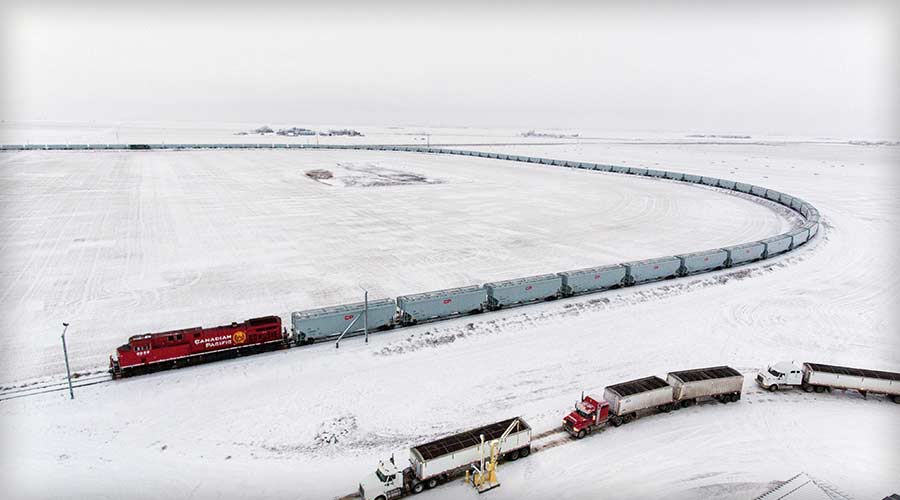CP continues to make headway with longer grain unit-train program
2/9/2023
By Jeff Stagl, Managing Editor
The high volumes of export grain flowing through Canada of late have been a boon for Canadian Pacific. During the 2022 crop season, the corn harvest set a record, the wheat harvest was the third-largest in history and soybean production increased more than 5%, according to Statistics Canada.
In fourth-quarter 2022, CP set a new monthly grain tonnage record and registered its second-highest quarterly grain revenue. In October alone, the railroad moved 3.14 million metric tons (MMT) of grain and grain products, besting the previous monthly record set in October 2020 by more than 100,000 MMT.
Plus, Q4 grain revenue shot up 49% to CA$655 million while volume climbed 24.3% to nearly 1.3 million units on a year-over-year basis.
CP notched another grain accomplishment in Q4, as well: Richardson International Ltd.’s new elevator in Carmichael, Saskatchewan, as of December became the latest facility capable of accommodating the Class I’s high-efficiency product (HEP) program involving 8,500-foot-long unit trains.
 In mid-January, Richardson International Ltd.’s new elevator in Carmichael, Saskatchewan, loaded its first HEP program train operated by CP. Canadian Pacific
In mid-January, Richardson International Ltd.’s new elevator in Carmichael, Saskatchewan, loaded its first HEP program train operated by CP. Canadian PacificDuring the week of Jan. 15, the elevator — which can store 45,000 metric tons of grain — loaded its first HEP train. Richardson International is Canada’s largest agribusiness.
CP continues to pursue an export grain supply-chain model in Canada that calls for loading, transporting and unloading 8,500-foot-long, power-on unit trains pulling a minimum of 134 hopper cars. HEP trains can move 20% more grain than typical 112-car grain trains, increasing the number of cars and volume of grain on each train, CP officials say.
The railroad continues to extend sidings and upgrade track so longer grain unit trains can move more seamlessly between elevators and ports.
The Class I expects to make more headway with the HEP program this year, CP Executive Vice President and Chief Marketing Officer John Brooks said Jan. 31 during the railroad’s fourth-quarter earnings conference.
“In 2023, we expect over 50 originating elevators will be 8,500-foot train capable, enabling us to continue to move record amounts of grain more efficiently,” he said. “We believe grain will continue to be an area of strength for us in 2023.”
That held true in the year’s first month. CP moved 2.29 MMT of Canadian grain and grain products in January, setting a new record for the month. Through January, CP had moved more than 15 MMT of grain and grain products in the 2022-23 crop year, up 45% compared with volume in the same period a year earlier.
 The Class I continues to extend sidings and upgrade track so longer grain unit trains can move more seamlessly between elevators and ports. Canadian Pacific
The Class I continues to extend sidings and upgrade track so longer grain unit trains can move more seamlessly between elevators and ports. Canadian Pacific Grain is CP’s largest market segment, with Canadian grain accounting for 66% of all traffic in that sector. The Class I’s network reaches the heart of grain-producing regions in western Canada. The railroad provides direct access from high-throughput unit train loading elevators to major export port terminals for shipments overseas.
Over the past several years, CP has spent CA$500 million to acquire 5,900 new high-capacity grain hoppers to boost efficiency. Including leased hoppers, the railroad now has more than 7,300 high-capacity cars in service.
Combined with the HEP program, the hoppers enable the Class I to move about 40% more grain per train. Each HEP train with the new high-capacity hoppers can move about 15,000 metric tons of grain versus the 12,000 metric tons that can be transported by a standard 7,000-foot unit train.
Recently, CP leaders recently called on the Canadian government and shipping industry to improve grain vessel loading operations because of an ongoing issue: slow going when it rains at West Coast terminals. At the Port of Vancouver, that issue is causing significant capacity constraints for exports of Canadian grain and agricultural products, the leaders say.
“Persistent rain delays in Vancouver disrupt the efficient, balanced cycling of rail cars from the port back to the in-country grain elevators in the prairies, where they are re-loaded with grain and transported back to the West Coast,” CP officials said in a press release. “These delays unavoidably reduce the grain supply chain’s velocity and export capacity.”


